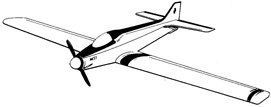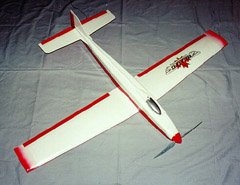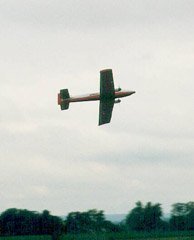Trials and Tribulations of an Ace Pacer Electric Conversion
June 1, 1999
While browsing through the East Coast Model Centre (now Great Hobbies) catalog about a year ago (1998), I came across an old Ace Pacer kit in the clearance section. I promptly ordered it, thinking it would make a great electric conversion. Well, things didn’t go very well at first, so I decided I’d write this down and share what I’ve learned.
The Pacer is a 40″ span pattern plane, intended for an .049 glow engine, with a recommended ready-to-fly weight of 22oz. The plane has a sheet balsa fuselage and tail, with a foam wing (the ubiquitous Ace foam wing, still used in the recently re-released Ace Simple Series of kits). The wing comes in three pieces which need to be butt-glued together. The trailing edge is then faced with balsa, and ailerons are hinged to this.
The Kit
This is not a kit review, but I’ve got to say that this is the worst kit I’ve ever built. Parts fit was horrible, and the airfoils of the foam wing sections weren’t consistent (they didn’t match where joined). I had to do a lot of sanding and shaping of parts that were supposedly preshaped. To better support the G-forces of hauling an electric flight battery around, I glassed the wing with 3/4oz glass cloth and water-based polyurethane varnish.
Plan “A”
My original plan was to build the plane stock, and equip it with a 6V Speed 400 motor, Modelair-Tech 2.14:1 gearbox, and Graupner 9×5 folding propeller, all running from seven 600AE or 600AA cells. I did my calculations using MotoCalc, and came up with the following performance figures:
| Weight | 25 oz |
| Wing Loading | 16.5 oz/sq.ft |
| Current | 9.7 A |
| Power Loading | 47 W/lb |
| Thrust | 12 oz |
| Pitch Speed | 31 mph |
| Stall Speed | 19 mph |
The power loading is high enough to fly the plane, although somewhat low for aerobatics. The big problem here is the pitch speed, which at 31mph is only slightly more than one and a half times the stall speed. According to Keith Shaw, an aerobatic aircraft should have a static pitch speed of at least 2.5 to 3 times the stall speed. Against my better judgement, I decided to go ahead anyway.
The first test flight was abysmal. After a difficult launch (always hard with a low-winged model, and even worse with an underpowered one), the plane just wallowed through the air. It required almost full up-elevator throughout the flight to keep the angle of attack high enough to generate enough lift at the slow top speed at which the motor could propel it.
After this flight, I went back to MotoCalc to see what other prop might work better. An 8×8 prop sounds like it would have worked well, absorbing about the same amount of power, but producing a pitch speed of 49 mph, about 2.5 times the stall speed.
Plan “B”
Before I got around to trying an 8×8 prop, I read an article by Pat Mattes on the E-Zone about his brilliant idea to convert a Bill Griggs Models Assault to a twin by replacing the single Speed 400 6V motor in the nose with a pair of Speed 400 4.8V motors on the wings, wired in series. The idea was to use the lower voltage motors wired in series so that the same battery packs could still be used. With an eight cell pack, each motor sees only four cells. This gave me the idea of converting the Pacer to a twin.
Instead of a a series arrangement of low voltage motors, which wouldn’t give any more power than the original single motor, I opted for a parallel arrangement of higher voltage motors, namely the 7.2V Speed 400. To supply the higher current demand, I decided to go from a 7-cell pack of 600AE cells (which are really only useful to about 10A) to an 8-cell pack of 800AR cells (useful to about 20A).
I mounted the motors to the leading edge of the wings on dowels. I drilled a pair of 3/16″ holes in each wing, about one inch apart. Into these I epoxied 3/16″ hardwood dowels, extending out the leading edge by about the length of a Speed 400 motor. I attached the motors to the dowel with nylon cable ties. I may build nacelles to cover the motors at some point in the future. The motors are connected to each other, and to an AstroFlight zero loss connector at the wing centre section, by 16ga flexible wire. I used a soldering iron to melt a slot into the wing, inserted the wire, applied a bead of RC-56 glue on top of the wire, and then filled the slot with lightweight filler.
The speed control (my ESC with brake and BEC design, as published in the 4-4 issue of Sailplane & Electric Modeler) is in the fuselage over the front of the wing, as is the receiver. With no motor in the nose, the 8-cell 800AR pack had to go in front of the wing to balance the plane.
For the first flight attempt, I used a pair of Dymond 6×4 folding propellers, with rubber bands installed to keep them from folding except during a belly landing. The first flight as a twin, carried out by Rob Pike, went much better than the original flight, although the plane stilled tended to wallow a bit. This is consistent with MotoCalc‘s predictions for this new power system:
| Weight | 33 oz |
| Wing Loading | 22 oz/sq.ft |
| Current | 17.5 A |
| Power Loading | 75 W/lb |
| Thrust | 18 oz |
| Pitch Speed | 41 mph |
| Stall Speed | 22 mph |
Notice that the pitch speed is now higher, but the stall speed has gone up due to all the extra weight. Based on the information from this test flight, I decided to try smaller, higher pitched propellers. Not wanting to buy (and risk breaking) two expensive Graupner CAM props, I decided to try the new APC 5.5×4.5 Speed 400 props. For this setup, MotoCalc predicts:
| Weight | 33 oz |
| Wing Loading | 22 oz/sq.ft |
| Current | 15.7 A |
| Power Loading | 68 W/lb |
| Thrust | 21 oz |
| Pitch Speed | 57 mph |
| Stall Speed | 22 mph |
Bingo!
Now this plane flies! It’s still a bit hairy to launch, but it quickly grips the air as the props unstall, and flies with authority. Even though the power is slightly lower than with the Dymond props, the performance is much better, because the power system is properly matched to the characteristics of the airframe. The Pacer now goes where you point it. Because of it’s relatively high wing loading, it has to fly quite fast. And with a low wing and no dihederal, it requires constant attention. It has absolutely no self-righting tendency, staying in whatever attitude you leave it in.
So, I’ve learned a lot about the importance of matching the power system to the airframe and intended application. Watts per pound isn’t enough. Even with the large increase in weight going from a 7x600AE powered single-motor to an 8x800AR powered twin-motor system, the better match between power system and airframe has resulted in a transformation from a plane that could barely get out of its own way, to one that really sizzles.
Related Articles
If you've found this article useful, you may also be interested in:
- Sig LT-25 Twin Electric Conversion
- Flit! A Speed 280 Four Channel Aerobat
- GravelMaster – A Cheap Tough Speed 400 Fun Plane
- Electrifying the Great Planes SlowPoke
- Sig Riser 100 Electric Conversion
- A Speed 400 PuddleMaster Flying Boat
- Spectra-V: A Modified Great Planes Spectra

If you've found this article useful, consider leaving a donation in Stefan's memory to help support stefanv.com
Disclaimer: Although every effort has been made to ensure accuracy and reliability, the information on this web page is presented without warranty of any kind, and Stefan Vorkoetter assumes no liability for direct or consequential damages caused by its use. It is up to you, the reader, to determine the suitability of, and assume responsibility for, the use of this information. Links to Amazon.com merchandise are provided in association with Amazon.com. Links to eBay searches are provided in association with the eBay partner network.
Copyright: All materials on this web site, including the text, images, and mark-up, are Copyright © 2025 by Stefan Vorkoetter unless otherwise noted. All rights reserved. Unauthorized duplication prohibited. You may link to this site or pages within it, but you may not link directly to images on this site, and you may not copy any material from this site to another web site or other publication without express written permission. You may make copies for your own personal use.




Dave mair
December 09, 2007
Would appreciate some comment in regard to stall speed. The calculation program results indicate a change in stall speed as a result of simply changing props. I was under the impression that stall speed was (only) a function of wing loading. Thanks.. dcm
Stefan Vorkoetter
December 09, 2007
Dave, it looks like I had copied down the MotoCalc results incorrectly when I wrote the article. After creating the first table of predictions, I copied and pasted to produce the second and third tables, and it appears that I forgot to update the stall speed in the third table (it showed the 19mph from the first table, although I’ve now corrected it in the article). You’re the first person to notice this discrepancy in the eight years the article has been on my web site.